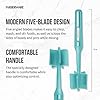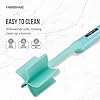Apple AirPods 4 Wireless Earbuds, Bluetooth Headphones, Personalized Spatial Audio, Sweat and Water Resistant, USB-C Charging Case, H2 Chip, Up to 30 Hours of Battery Life, Effortless Setup for iPhone
22% OffNuGet packages (.nupkg files) contain reusable code libraries that can be incorporated into .NET projects to add functionality and save development time. Installing NuGet packages with PowerShell provides a fast, automated way to get libraries integrated.
In this comprehensive guide, you’ll learn:
- What NuGet is and how it works
- The benefits of using NuGet packages
- How to find and download .nupkg files
- How to install packages into projects using PowerShell
- PowerShell commands for querying and managing packages
- Tips for troubleshooting package installation issues
Follow along and you’ll be managing NuGet dependencies like a pro with PowerShell scripts in no time!
What is NuGet and How Does It Work?
NuGet is an open source package manager used for sharing and installing .NET libraries and frameworks. It serves as a central repository containing thousands of useful code packages to add capabilities to .NET apps.
The key advantages of NuGet include:
- Dependency management – Automatically installs and references packages your projects require.
- Version control – Supports different package versions and updating to newer releases.
- Centralized repository – Public and private registries make finding and downloading packages easy.
- Consistency – Standardizes project dependencies and configurations across teams.
- PowerShell integration – Automates package management tasks using PowerShell cmdlets.
NuGet Packages
NuGet packages contain compiled code libraries bundled into .nupkg files. They may include:
- .NET assemblies
- Native DLLs
- Resource files
- Config files
- Tools
- Scripts
- License docs
The .nupkg zipped folder structure contains the assemblies along with key metadata like version numbers, authors, descriptions, and dependencies in special manifest files.
Package Repositories
Public and private NuGet repositories host thousands of downloadable packages:
- nuget.org – Public repository containing over 150,000 open source packages.
- Private feeds – Organizations can host internal packages securely using NuGet server products like Azure Artifacts.
The NuGet CLI and client tools interact with repositories to search, download, and publish packages. PowerShell cmdlets work directly with the repositories as well.
Package Restore
NuGet can automatically download and install all the necessary package dependencies for a project during build time.
By sharing a simple packages.config or .csproj file that lists dependencies, NuGet will pull any missing packages from repositories and add references to projects before compiling code.
This powerful restore function keeps teams in sync and saves tons of manual package installation effort.
Now that you understand NuGet basics, let’s look at why using NuGet packages is so beneficial for .NET development.
Benefits of Using NuGet Packages
Here are some of the top reasons to manage .NET dependencies with NuGet:
Reduce Reinvention of Common Code
NuGet packages contain pre-built solutions for common tasks that you can reuse instantly instead of writing from scratch. Why code up logging, parsing, authentication etc. yourself when trusted implementations already exist?
Incorporate Robust Frameworks Quickly
Packages like Entity Framework, React.js, and Bootstrap add full robust frameworks and expansive functionality faster than building in-house.
Stay Updated with Latest Releases
As package authors update their code and release new versions, NuGet allows you to upgrade seamlessly. Never get stuck managing legacy package code yourself.
Discover New Libraries
Browsing NuGet repositories exposes you to great new specialty packages you may never have encountered otherwise for math, econometrics, analytics, and more.
Promote Open Source Sharing
Contributing your own useful packages back to the community promotes more collaboration and innovation in the .NET ecosystem.
Synchronize Team Dependencies
Using a shared packages.config allows all developers to pull same package versions, ensuring consistency and avoiding bugs from mismatches.
Automate tedium
NuGet handles all the tedious parts of obtaining, integrating, and upgrading packages automatically with just a few clicks.
Now that you see the many benefits NuGet packages provide, let’s move on to finding and downloading the ones you need.
Finding and Downloading NuGet Packages
With over 150,000 packages and growing, how do you find the perfect NuGet packages to use? Here are some strategies:
Browse nuget.org
The official public repository at nuget.org provides:
- Search by keywords to find relevant packages
- Filter by category like cloud, containers, databases etc.
- Sort by popularity, relevance, published date etc.
- See ratings, descriptions, version histories and more
Check Project Pages
Many open source .NET projects publish and recommend their own NuGet packages like:
- ASP.NET Core
- Entity Framework
- ML.NET
- Xamarin
Check their project pages for details on getting started with their packages.
Ask for Recommendations
Speaking to other .NET developers and asking for package suggestions on forums like StackOverflow can uncover great options.
Review Package Sources
Scan the source code of .NET libraries you like on Github and check their build scripts for NuGet dependencies you could leverage.
Once you’ve identified useful packages to install, acquiring them is straightfoward:
Download via nuget.org Web UI
- Browse nuget.org and select a package
- On the package page, find the latest version and click Download
- Save the
.nupkgfile locally
nuget.exe CLI Tool
- Open a command prompt
- Run
nuget install [PACKAGE_NAME] - The
.nupkgfile will be downloaded to local packages folder
Visual Studio UI
- In Visual Studio, open the NuGet Package Manager
- Browse to find your package and click Install
- The IDE will handle downloading automatically
Now you have .nupkg package files ready to integrate into projects using PowerShell!
Installing NuGet Packages with PowerShell
PowerShell provides an automated way to install NuGet packages into projects with scripts instead of manual point-and-click.
Here are the key steps to add packages via PowerShell:
- Open PowerShell
- Navigate to project directory
- Install NuGet provider
- Import
.nupkgfile - Call
Install-Packageon project
Let’s look at sample commands for each piece:
1. Launch PowerShell
Start a PowerShell session by running powershell.exe from the Start menu.
2. Navigate to Project
Change to your project’s directory that will receive the package.
cd C:\Projects\MyApp
3. Install NuGet Provider
The NuGet PS provider extends PowerShell with NuGet capabilities. Install it with:
Install-PackageProvider NuGet -Force
4. Import .nupkg File
Import the .nupkg file into the local NuGet repository:
Register-PackageSource -Name MyPackages -Location C:\packages -ProviderName NuGet
5. Install Package
Finally, install the package into the project:
Install-Package Newtonsoft.Json -Source MyPackages
This will add all required assemblies, imports, and references to integrate the Newtonsoft JSON package.
You can combine the steps into a single PowerShell script. Specify the exact package version if desired:
# Install NuGet Provider
Install-PackageProvider NuGet -Force
# Import Package
Register-PackageSource -Name MyPackages -Location C:\packages -ProviderName NuGet
# Install Package into Project
Install-Package Newtonsoft.Json -Version 12.0.1 -Source MyPackages
Executing this ensures the package gets imported and set up correctly every time with no manual intervention needed!
Alternative: Install from NuGet Repository
Instead of pre-downloading .nupkg files, you can install packages directly from an online NuGet repository like nuget.org:
# List available package sources
Get-PackageSource
# Add nuget.org if missing
Register-PackageSource -Name nuget.org -Location https://www.nuget.org/api/v2 -ProviderName NuGet
# Install package from nuget.org
Install-Package Newtonsoft.Json -Source nuget.org
This queries the repository for the latest version and pulls it down on the fly.
PowerShell Commands for NuGet Packages
Beyond Install-Package, PowerShell provides tons of useful NuGet commands for managing packages:
Get-Package– Lists installed packages and versionsFind-Package– Searches repositories to find packagesSave-Package– Downloads packages to local storageUninstall-Package– Removes and unreferences packagesUpdate-Package– Updates packages to newer versionsGet-Project -All– Displays projects in the solutionSync-Package– Synchronizes packages from one project to another
You can run these individually, but they really shine when combined into PowerShell scripts that automate your workflows:
Update All Packages
# List each project
Get-Project -All | ForEach-Object {
# Set current project
Set-Location $_.FullName
Write-Host Updating $($_.Name)
# Update each installed package
Get-Package -ProjectName $_.Name | ForEach-Object {
Update-Package -ProjectName $_.ProjectName -Id $_.Id -Version $_.Version
}
}
This loops through each project, lists its packages, and updates them to the latest versions automatically!
Move Package to Another Project
# Define source and destination projects
$sourceProj = "MyApp"
$destProj = "MyApp.Web"
# Get package to move
$package = Get-Package -ProjectName $sourceProj | Where-Object Id -eq "Newtonsoft.Json"
# Uninstall from source
Uninstall-Package -Id $package.Id -Version $package.Version -ProjectName $sourceProj
# Install into destination
Install-Package -Id $package.Id -Version $package.Version -ProjectName $destProj
Quickly migrates a package between projects with no hassle!
The package management automation possibilities are endless with PowerShell.
Troubleshooting Package Installation
Though NuGet installation through PowerShell is generally straightforward, you may encounter issues like:
- Unexpected errors installing or updating packages
- Assemblies not being referenced correctly
- Old package versions remaining after update
- Inconsistent behavior across environments
Here are some tips for troubleshooting:
- Confirm the NuGet provider is installed properly in PowerShell
- Check for typos in PowerShell package IDs or source names
- Try reimporting the
.nupkgfile into local repository - Use verbose logging with
-Verboseflag on commands - Identify differences in
packages.configacross environments - Restart Visual Studio and rebuild solution after PowerShell updates
- Clear NuGet caches by deleting project
packagesfolders - Reset repository sources and reinstall NuGet client tools
- Search NuGet issues on GitHub in case its a known bug
With patience and care, you can resolve most erratic issues that arise with PowerShell NuGet integration. Don’t hesitate to reach out to package authors on forums if all else fails.
Putting It All Together
In summary, here is a step-by-step guide to install NuGet packages via PowerShell:
1) Find useful NuGet packages for your project needs
2) Download .nupkg files from nuget.org or other sources
3) Launch PowerShell and navigate to your project folder
4) Install the NuGet package provider if missing
5) Call Register-PackageSource to import packages into local repository
6) Use Install-Package to add packages to projects
7) Manage packages further with commands like Update-Package or Uninstall-Package
8) Build automation scripts to perform workflows like bulk upgrading
9) Debug issues by checking logs, clearing caches, and verifying configurations
Following these best practices will have you productively managing NuGet dependencies from PowerShell. Your projects will integrate the latest community code with minimal hassle.
NuGet packages allow standing on the shoulders of .NET giants who’ve solved common problems before. Automate integrating these powerful libraries using PowerShell, and you’ll transform how quickly your projects progress.
So try out a useful new package today using these techniques! With the vast NuGet ecosystem just a few keystrokes away, your next great project is closer than ever.

Greetings! I am Ahmad Raza, and I bring over 10 years of experience in the fascinating realm of operating systems. As an expert in this field, I am passionate about unraveling the complexities of Windows and Linux systems. Through WindowsCage.com, I aim to share my knowledge and practical solutions to various operating system issues. From essential command-line commands to advanced server management, my goal is to empower readers to navigate the digital landscape with confidence.
Join me on this exciting journey of exploration and learning at WindowsCage.com. Together, let’s conquer the challenges of operating systems and unlock their true potential.













